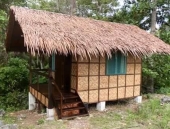Dale Hodgins wrote:I would like to replace it with a cob house.
Do
NOT build a cob house there!!
My background - An International On-Scene-Commander for major disasters like earthquakes. In this regard I have designed earthquake proof houses using flexible concrete. Not cheap but they won't collapse.
I have work as a
consultant to developing nations and have a consulting partner, who is Filipino, and has spent 13 years with the World Bank and 21 years with UNDP.
That being said, a cob house would become an oven in the heat and humidity in this area. It will collapse with either the first typhoon or first earthquake to hit this quake prone area, that is, if the cob doesn't dissolve in the first tropical rainstorm.
IF mud huts would have worked, they would already be using the technology. They don't.
Bamboo is 1) readily available and cheap; 2) extremely strong and flexible. Look at some images of bamboo scaffolding in Asia. 3) the bamboo and thatch design used traditionally in these areas of Asia breathes, so is cooler 4) typhoon winds pass through the thatch rather than offering a high degree of resistance.
Wind Pressures per square foot are extremely high. Look at what the recent hurricane did in the Florida Panhandle. In rescue work,
RED is the highest warning level. We seldom get them for a hurricane in North America but get them constantly for the Typhoons in Asia. It is the sapling that bends with the wind that survives.
Spend your money wisely. Hire the locals to cut bamboo and build her a newer, larger, traditional design, home. Add some luxuries like solar energy panels and a
BioDigester for methane gas generation. BTW, this BioGas unit is the one used in the Philippines. We took it a step farther using the digested dung to make pellet fuel so that nothing is wasted and every ounce of energy is extracted.
Rethink your project. Use what's locally available. More than one family can benefit from a BioGas system. I think some MIT engineering students developed a power system form an old car alternator and a simple wind turbine. They have been powering villages in Africa with this system.
Good luck and enjoy changing their lives.




